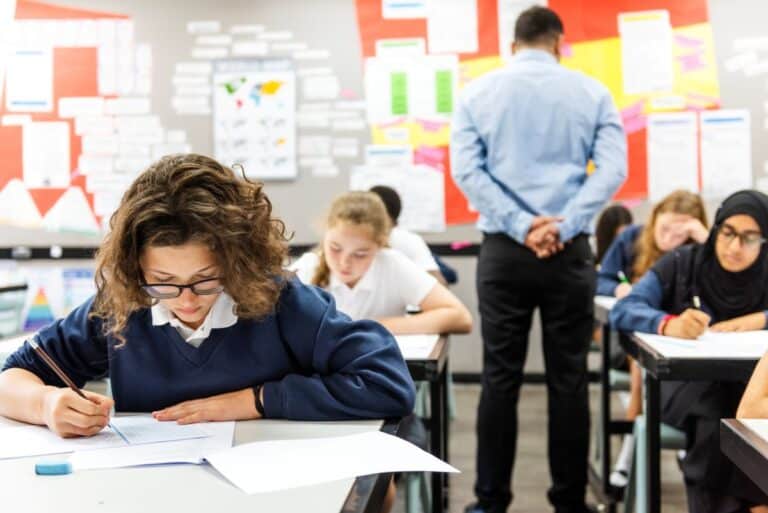Summative assessments are typically the last step in the teaching and learning process. They are meant to show what students have truly learned and can do, not just what they have memorized for a test. They are intended to give a picture of student mastery and highlight the skills and knowledge that matter most.
Here we’ll take a closer look at the purpose and types of summative assessments, why they matter, and how to best design them so they will truly reflect your students’ learning.
The Purpose of Summative Assessments
Summative assessments are designed to evaluate student learning at the end of a unit or course. The goal is to see if the student has mastered the material. They essentially provide a snapshot of achievement after instruction is complete, whereas formative assessments check for understanding during the learning process.
Traditionally, summative assessments meant unit tests, midterms, and final exams. While these can be a useful tool, they don’t measure skills like critical thinking, problem solving, or creativity. That’s why today’s educators are considering alternative ways to assess learning.
Moving Beyond Memorization
While memorization is a good indicator that students have learned the information, it doesn’t show if they can apply concepts in new or complex situations. Assessments need to capture a variety of skills like analysis and communication, not just the ability to memorize definitions.
For example, a history exam that asks students to recall specific dates of battle only tells you that they have memorized dates, but a project that asks students to analyze the causes of war provides a better understanding of the concept. It also demonstrates higher-order thinking skills.
Types of Summative Assessments
There are many ways to assess learning besides the traditional test. Here are a few different ways you can try in your classroom.
Projects
Projects give students the chance to show what they have learned in a creative way that reflects their unique personality. Whether it’s a research project, science experiment, or multimedia project, it gives insight into how students learned the information. Not to mention, it encourages ownership and pride in their work.
Portfolios
Portfolios show a collection of students’ work throughout a unit or semester. They are valuable tools for students because they can look back and see their progress and reflect on what they’ve learned. For teachers, portfolios are helpful because they show any patterns in students’ strengths or weaknesses that an exam would not cover.
Presentations
Presentations give students a chance to share what they’ve learned in their own voice and style. Whether they choose an oral presentation or a video presentation, they allow students a unique way to explain concepts and engage with an audience. They also help to strengthen communication skills, which is a skill they will use far beyond the classroom.
Performance Tasks
Performance tasks put students in real-world scenarios where they must use their knowledge to solve a problem. For example, a math class may design a grocery budget, while an English class may write a persuasive essay to a local official. These tasks show students how they can take what they’ve learned in class and use it in real life.
Written exams
Traditional written exams can be useful just as long as they are redesigned to include open-ended questions or more opportunities for students to explain their reasoning. This will help students demonstrate their understanding instead of just remembering the facts.
Designing Effective Summative Assessments
Effective summative assessments take some planning. Here are a few things to keep in mind.
- All assessments should be tied back to what you have taught.
- Balance assessments to include a variety of projects, presentations, and tests to be fair to all students.
- Give students rubrics so they can see exactly what you are looking for.
- Have students reflect on what they’ve learned to help them process what they’ve learned.
Benefits of Summative Assessments
When assessments go beyond simple recall, students can see why their learning matters, which keeps them motivated. They walk away with important skills like teamwork and communication.
For teachers, these kinds of assessments provide a deeper look at student growth that goes beyond just recalling facts. You get to see how students apply concepts, connect ideas, and think critically. This kind of feedback can help guide your teaching and lesson planning.
How to Overcome any Challenges
The ultimate goal of summative assessments is to capture a genuine understanding of how well students understand what they are learning. While traditional tests have value, they are only one piece of the picture and should be combined with other meaningful measures of assessment, like projects, portfolios, and presentations. When using a lot of different means of assessment, you are giving students a fair chance to show what they know.
Summative assessments should measure real student understanding and the ability to apply what they’ve learned in various ways. While traditional tests still have a place in the classroom, they should just be one part in a broader strategy. Integrating projects, presentations, and performance tasks gives students a fair chance to show what they’ve learned. Together, these approaches will give you a complete picture of student understanding.
You’ve got important career goals — we have the graduate program to get you there. Check out our available graduate degree programs to advance your career today!




